Failure and Energy Evolution Characteristics of Saturated Natural Defective Material Under Different Confining Pressures
Abstract
1. Introduction
2. Water-Saturated Test Material Preparation and Programs
2.1. Water-Saturated Defective Brittle Material Specimen Preparation
2.2. Characterization of the Basic Mineral Composition and Microstructure of Natural Defective Materials
2.3. Test Setup and Test Program
3. Mechanical Properties and Deterioration Law of Water-Saturated Natural Defective Materials
3.1. Stress–Strain Analysis
3.2. Analysis of the Law of Change of Mechanical Parameters of Natural Defective Materials
3.3. Damage Characteristics of Water-Saturated Natural Defective Rock Materials Under Different Confining Pressures
4. Numerical Simulation Based on Discrete Element Method
4.1. Principle and Parameter Calibration
4.2. Spatio-Temporal Evolution Law of Rift Network
4.3. Mechanism of Fine-Scale Evolution of Water-Saturated Natural Defective Materials
5. Mechanisms of Energy Evolution in Water-Saturated Natural Defective Materials
5.1. Principles of Energy Calculation
5.2. Characterization of Energy Evolution
5.3. Characterization of Energy Accumulation and Dissipation
- (1)
- The elastic energy storage ratios of defective rock materials with and without pressure enclosure and water saturation show nonlinear changes. Specifically, the elastic energy storage ratio increases with the strain ratio prior to reaching the peak load.
- (2)
- The elastic energy storage ratios of materials with and without confining pressure are essentially similar during the compression stage. However, in the elastic and plastic phases, the elastic energy storage ratios of materials with confining pressure are higher than those without confining pressure. In the peak phase, the elastic energy storage ratios of both materials reach their maximum values and are comparable.
- (3)
- The elastic storage ratio of water-saturated materials with confining pressure is larger than that of water-saturated materials without confining pressure at any stage. When the strain ratio is <0.94, the elastic storage rate of water-saturated materials with higher confining pressure is the largest. However, when the strain ratio is >0.94, the elastic storage ratio of water-saturated materials with higher confining pressure is progressively smaller than that of materials with lower confining pressure.
6. Discussion
- (1)
- Energy Accumulation and Release Under Confining Pressure
- (2)
- Nonlinear Relationship Between Elastic Energy Storage Ratio and Strain Ratio
- (3)
- Structural Stability and Limitations
7. Conclusions
- (1)
- The peak stress and elastic modulus of defective rock materials under dry conditions are higher than those under water-saturated conditions. Under different confining pressures, the compressive strength and elastic modulus of water-saturated materials exhibit a positive correlation with the level of confining pressure, while the Poisson’s ratio shows a negative correlation with the level of confining pressure. Specifically, as the confining pressure is raised from 0 MPa to 20 MPa, the compressive strength increases by 126.8%, the elastic modulus increases by 91.9%, and the Poisson’s ratio decreases by 39%.
- (2)
- The critical stresses of defective rock materials in dry conditions are higher than those in water-saturated conditions. In the gradual process of damage of water-saturated materials, the crack closure stress, crack initiation stress, and damage stress exhibit a positive correlation with the level of confining pressure. Specifically, as the confining pressure increases from 0 MPa to 20 MPa, the crack closure stress grows by 42.7%, the crack initiation stress grows by 98.7%, and the damage stress grows by 124.2%. Furthermore, the confining pressure slows down the crack initiation and damage processes of water-saturated materials.
- (3)
- The damage mode of water-saturated material shifted from tensile damage mode to shear damage mode under different confining pressures. Additionally, the level of confining pressure exhibited a negative correlation with the crack inclination angle. The angle of rupture of the material decreased from 87° to 50.3° as the confining pressure was raised from 0 MPa to 20 MPa.
- (4)
- Under varying pressures, cracks in water-saturated materials initiated from the vertical direction around to the middle tilt direction. The crack extension direction was concentrated in the interval of 45~135°. Furthermore, the formation of shear cracks exhibited a strong positive correlation with the level of confining pressure. Specifically, the ratio of shear cracks increased from 12.1% to 27.7% as the confining pressure rose from 0 MPa to 20 MPa.
- (5)
- The energy characteristics of water-saturated materials exhibit a significant positive correlation with the level of confining pressure. When the confining pressure increases from 0 MPa to 20 MPa, the total energy increases by 277%, the elastic energy increases by 271%, and the dissipation energy increases by 401%. Furthermore, the elastic storage rate generally displays a positive correlation with the level of confining pressure. However, a negative correlation appeared when the strain ratio was greater than 0.94.
Author Contributions
Funding
Institutional Review Board Statement
Informed Consent Statement
Data Availability Statement
Conflicts of Interest
References
- Li, W.; Zhang, Q.; Wang, X.; Yu, L.; Li, Z. Synergistic effect of particle size, carboxymethyl starch and Na2CO3 on rheological and filtration property of bentonite-based material. Case Stud. Constr. Mater. 2024, 21, e03537. [Google Scholar] [CrossRef]
- Xu, R.; Zhao, Y.; Dou, B.; Hou, R.; Li, Z.; Dong, J. Experimental investigation of the effect of strain rate on the cracking behaviour and acoustic emission characteristics of red sandstone containing orthogonal cross flaws under quasistatic uniaxial compression. Eng. Fail. Anal. 2025, 170, 109323. [Google Scholar] [CrossRef]
- Li, W.; Yu, L.; Zhang, T.; Su, H.; Mi, X.; Fan, D.; Jin, B. Quantitative analysis of grain size effect on tensile mechanical behavior of granite based on multi-level force chain networks. Comput. Part. Mech. 2024, 11, 2245–2266. [Google Scholar] [CrossRef]
- Xu, R.; Gao, L.; Jin, Y.; Wang, Y.; Li, Z.; Hu, S. Influence of strain measurement methods on crack initiation and crack damage thresholds of shale. Geomech. Geophys. Geo Energy Geo Resour. 2025, 11, 34. [Google Scholar] [CrossRef]
- Xie, H.; Zhang, R.; Zhang, Z.; Gao, M.; Li, C.; He, Z.; Li, C.; Liu, T. Reflections and explorations on deep earth science and deepearth engineering technology. J. China Coal Soc. 2023, 48, 3959–3978. [Google Scholar]
- Tao, M.; Wu, X.; Zhao, R. Advancements and future prospects of mechanical characteristics of rock stress gradients. J. Cent. S. Univ. (Sci. Technol.) 2024, 55, 4473–4492. [Google Scholar] [CrossRef]
- Han, J.; Hu, S.; Gao, Z.; Huang, J.; Cheng, Y.; Guo, S.; Yang, L. A discrete element study of the fracture propagation of rock-like materials under directional sleeve fracturing. Theor. Appl. Fract. Mech. 2024, 130, 104317. [Google Scholar] [CrossRef]
- Guo, S.; Hu, S.; Huang, J.; Gao, Z.; Cheng, Y.; Han, J.; Yang, L. Stability control technology for surrounding rocks in gob-side entry driving with small coal pillars under dynamic pressure. Energies 2023, 16, 7887. [Google Scholar] [CrossRef]
- Colback, P.S.B.; Wild, B.L. Influence of moisture content on the compress strength of rock. In Proceedings of the 3rd Canadian Rock Mechanics Symposium, Toronto, ON, Canada, 15–16 January 1965; Society of Exploration Geophysicists: Houston, TX, USA, 1965; pp. 385–391. [Google Scholar]
- Li, W.; Yu, L.; Tan, Y.; Wu, L.; Qian, J. Mechanical properties and impact behavior of frozen clay: Insights from static mechanical tests, fly-plate tests, and split-Hopkinson pressure bar analysis. Phys. Fluids 2024, 36, 057138. [Google Scholar] [CrossRef]
- Song, C.; Feng, G.; Bai, J.; Cui, J.; Wang, K.; Shi, X.; Qian, R. Progressive failure characteristics and water-induced deterioration mechanism of fissured sandstone under water–rock interaction. Theor. Appl. Fract. Mech. 2023, 128, 104151. [Google Scholar] [CrossRef]
- Chen, X.; Eichhubl, P.; Olson, J.E. Effect of water on critical and subcritical fracture properties of Woodford shale. J. Geophys. Res. Solid Earth 2017, 122, 2736–2750. [Google Scholar] [CrossRef]
- Zhao, Y.; Tang, J.; Wang, W.; Cheng, G.; Luo, S.; Fu, C. Study on failure behavior of fluid-solid coupling under conventional triaxial compression for Maokou limestone. J. Min. Saf. Eng. 2018, 35, 205–212. [Google Scholar]
- Luo, S.; Yan, P.; Lu, W.; Dong, Z.; Zhou, C.; Yang, Z.; Hu, Y. Stability index of surrounding rock during deep rock excavation considering energy release speed. Appl. Sci. 2023, 13, 3000. [Google Scholar] [CrossRef]
- Vardar, O.; Zhang, C.; Canbulat, I.; Hebblewhite, B. Numerical modelling of strength and energy release characteristics of pillar-scale coal mass. J. Rock Mech. Geotech. Eng. 2019, 11, 935–943. [Google Scholar] [CrossRef]
- Zhang, W.; Feng, J.; Ma, J.; Shi, J. The revealed mechanism of rock burst based on an Innovative calculation method of rock mass released energy. Int. J. Environ. Res. Public Health 2022, 19, 16636. [Google Scholar] [CrossRef] [PubMed]
- Hu, S.; Zhang, C.; Ru, W.; Han, J.; Guo, S.; Zhou, X.; Yang, L. Creep properties and energy evolution characteristics of weakly cemented rock under step loading. Int. J. Rock Mech. Min. Sci. 2023, 170, 105428. [Google Scholar] [CrossRef]
- Zhang, J.; Song, Z.; Wang, S. Experimental investigation on permeability and energy evolution characteristics of deep sandstone along a three-stage loading path. Bull. Eng. Geol. Environ. 2021, 80, 1571–1584. [Google Scholar] [CrossRef]
- Xie, H.; Gao, F.; Yang, J. Research and exploration of rock mechanics in deep ground engineering. Chin. J. Rock Mech. Eng. 2015, 34, 2161–2178. [Google Scholar] [CrossRef]
- Meng, Z.P.; Pan, J.N.; Liu, L.L.; Meng, G.X.; Zhao, Z.H. Influence of moisture contents on mechanical properties of sedimentary rock and its bursting potential. Chin. J. Rock Mech. Eng. 2009, 28 (Suppl. 1), 2637–2643. [Google Scholar]
- Lai, X.; Zhang, S.; Cui, F.; Wang, Z.; Xu, H.; Fang, X. Energy release law during the damage evolution of water-bearing coal and rockand pick-up of AE signals of key pregnancy disasters. Chin. J. Rock Mech. Eng. 2020, 39, 433–444. [Google Scholar] [CrossRef]
- Liu, W.; Yan, E.; Dai, H.; Du, Y.; Xiao, W.B.; Zhao, S. Study on characteristic strength and energy evolution law of Badong formationmudstone under water effect. Chin. J. Rock Mech. Eng. 2020, 39, 311–326. [Google Scholar] [CrossRef]
- Liu, Y.; He, C.; Fu, H.; Wang, S.; Lei, Y.; Peng, Y. Study on tensile mechanical properties and energy consumption law of saturatedslate under impact loads. Chin. J. Rock Mech. Eng. 2020, 39, 2226–2233. [Google Scholar] [CrossRef]
- Guo, J.; Liu, X.; Qiao, C. Experimental study of mechanical properties and energy mechanism of karst limestone under natural and saturated states. Chin. J. Rock Mech. Eng. 2014, 33, 296–308. [Google Scholar] [CrossRef]
- Gao, F.; Cao, S.; Zhou, K.; Lin, Y.; Zhu, L. Damage characteristics and energy-dissipation mechanism of frozen–thawed sandstone subjected to loading. Cold Reg. Sci. Technol. 2020, 169, 102920. [Google Scholar] [CrossRef]
- Yang, Y.; Ma, D. Experimental research on energy evolution properties of coal sample failure under triaxial unloading testing. J. Min. Saf. Eng. 2018, 35, 1208–1216. [Google Scholar] [CrossRef]
- Zhao, Y.; Gong, S.; Huang, Y. Experimental study on energy dissipation characteristics of coal samples under impact loading. J. China Coal Soc. 2015, 40, 2320–2326. [Google Scholar] [CrossRef]
- Huang, M.; Zhang, J.; Hu, L.; Zhang, X. SplitHopkinson pressure bar test and energy dissipationcharacteristics of argillaceous siltstone in Three Gorgesreservoir region. J. Eng. Geol. 2015, 23, 1175–1181. [Google Scholar] [CrossRef]
- Peng, Y.; Yu, L.; Qian, J.; Li, W.; Zhang, T.; Zhou, L. Dynamic tensile behavior and crack propagation in coral aggregate seawater shotcrete: Experimental investigation and numerical simulation. Cem. Concr. Compos. 2025, 159, 106010. [Google Scholar] [CrossRef]
- Jiang, J.; Chen, S.; Xu, J.; Liu, Q. Mechanical properties and energy characteristics of mudstone under different containing moisture states. J. China Coal Soc. 2018, 43, 2217–2224. [Google Scholar] [CrossRef]
- Ru, W.; Hu, S.; Li, D.; Ma, J.; Zhang, C.; Luo, P.; Gong, H.; Zhou, A. Energy evolution of unloading confining pressure and dissipative energy damage constitutive model of coal-rock combination. J. Rock Soil Mech. 2023, 44, 3448–3458. [Google Scholar] [CrossRef]
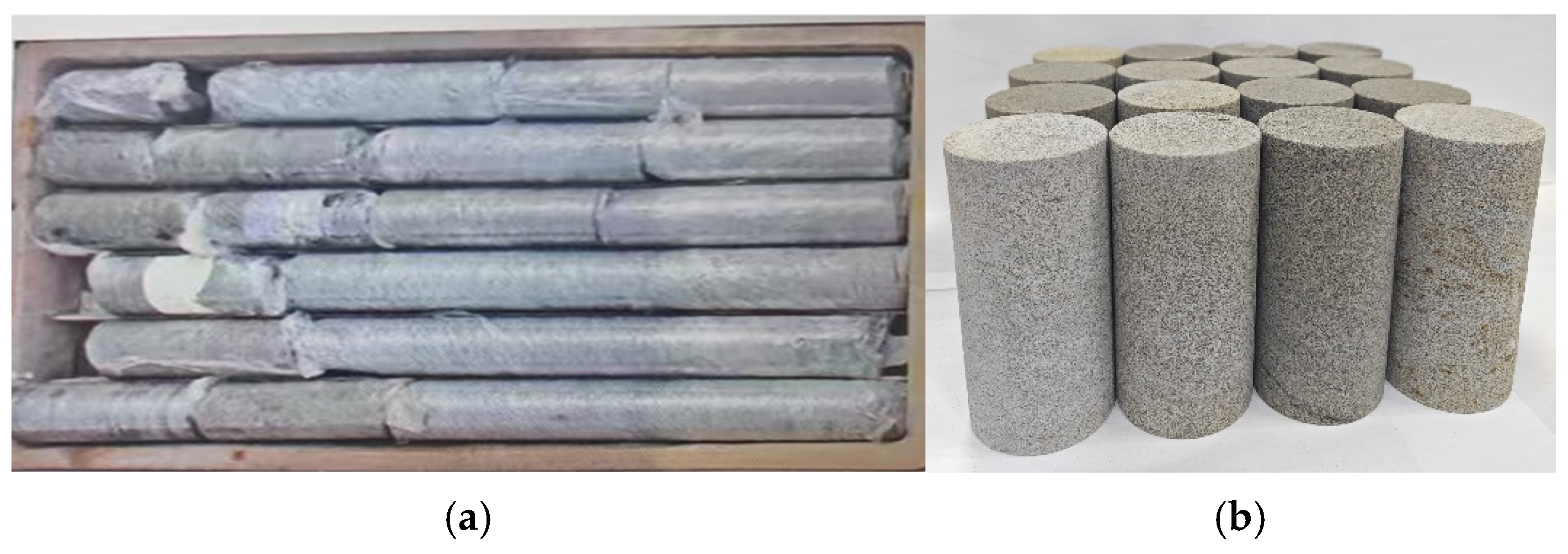
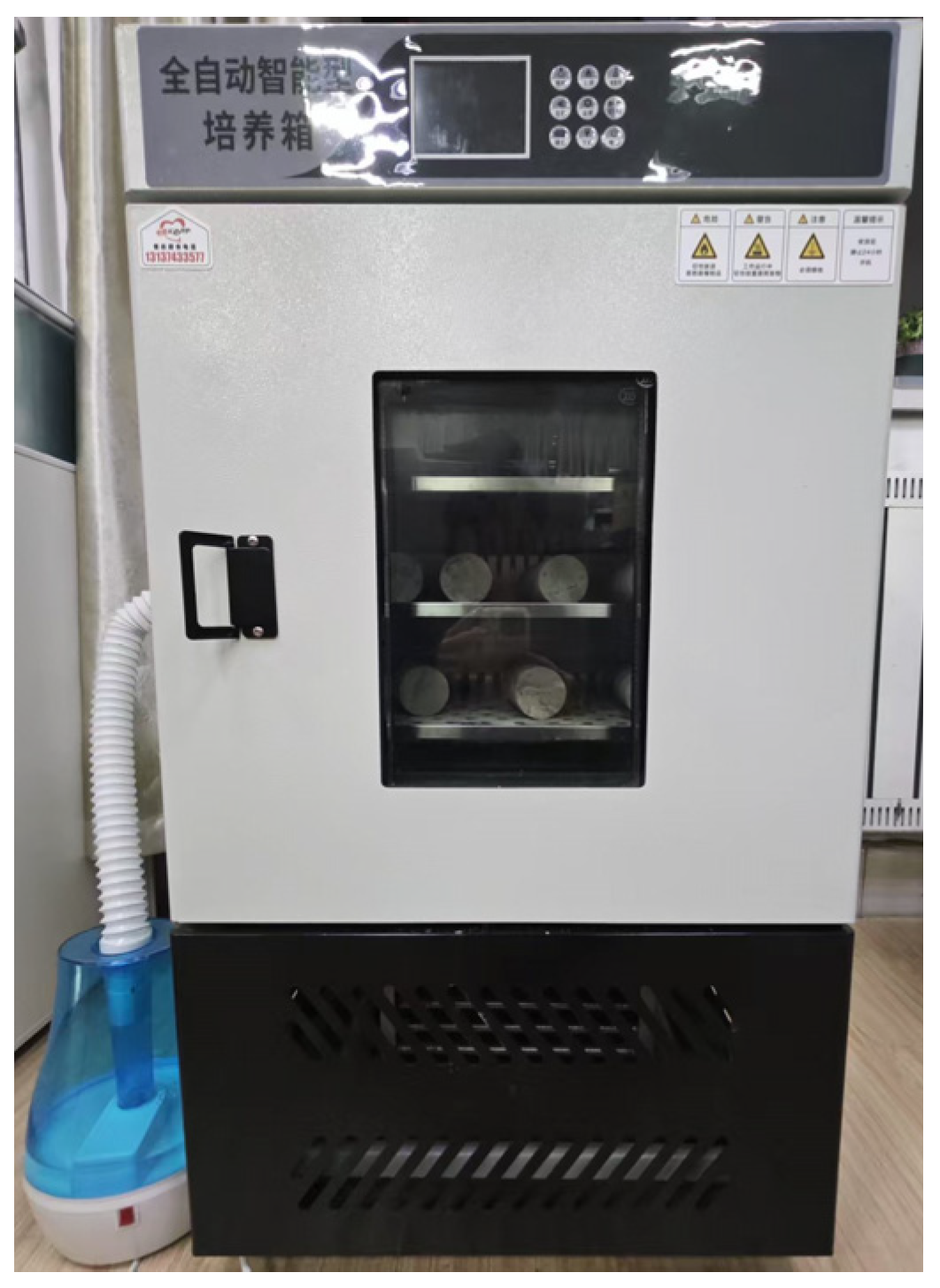


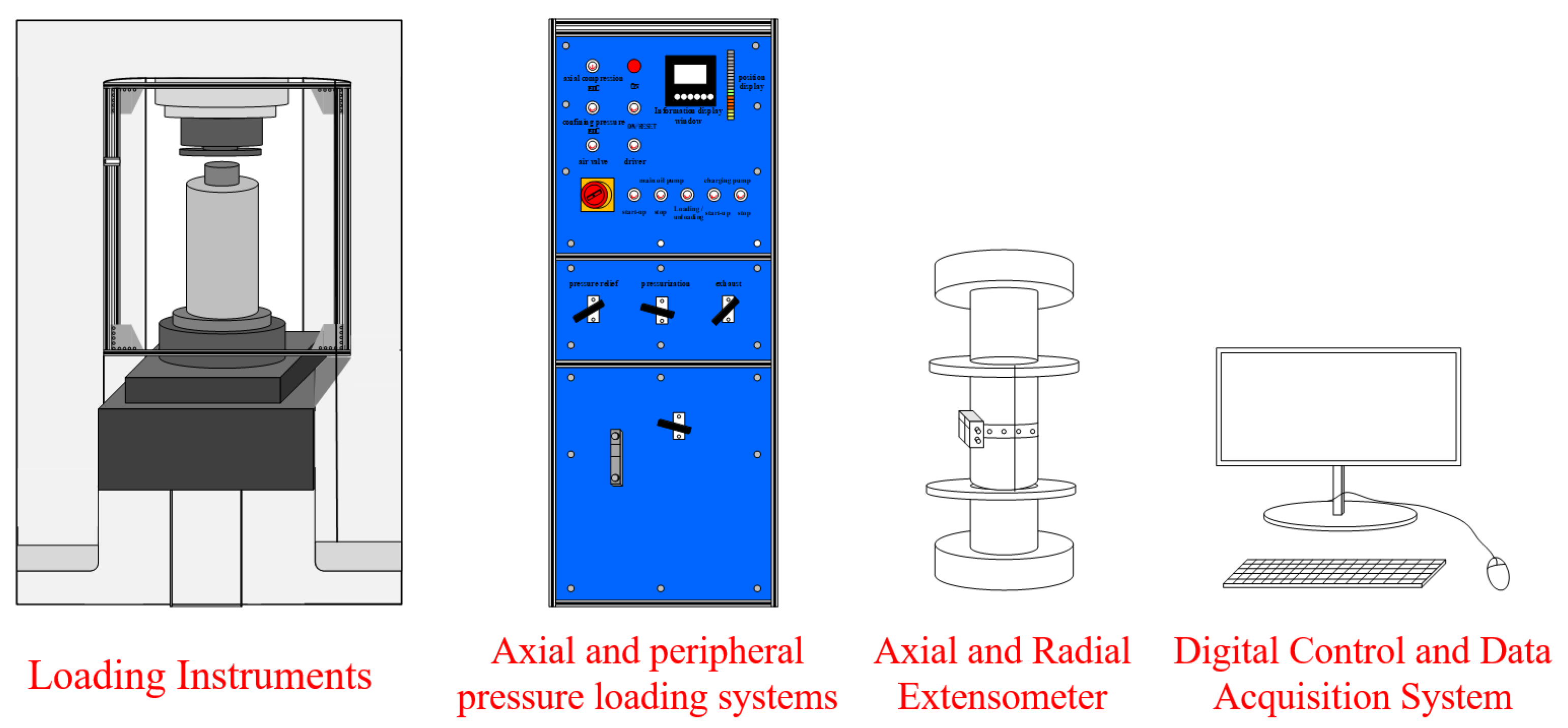
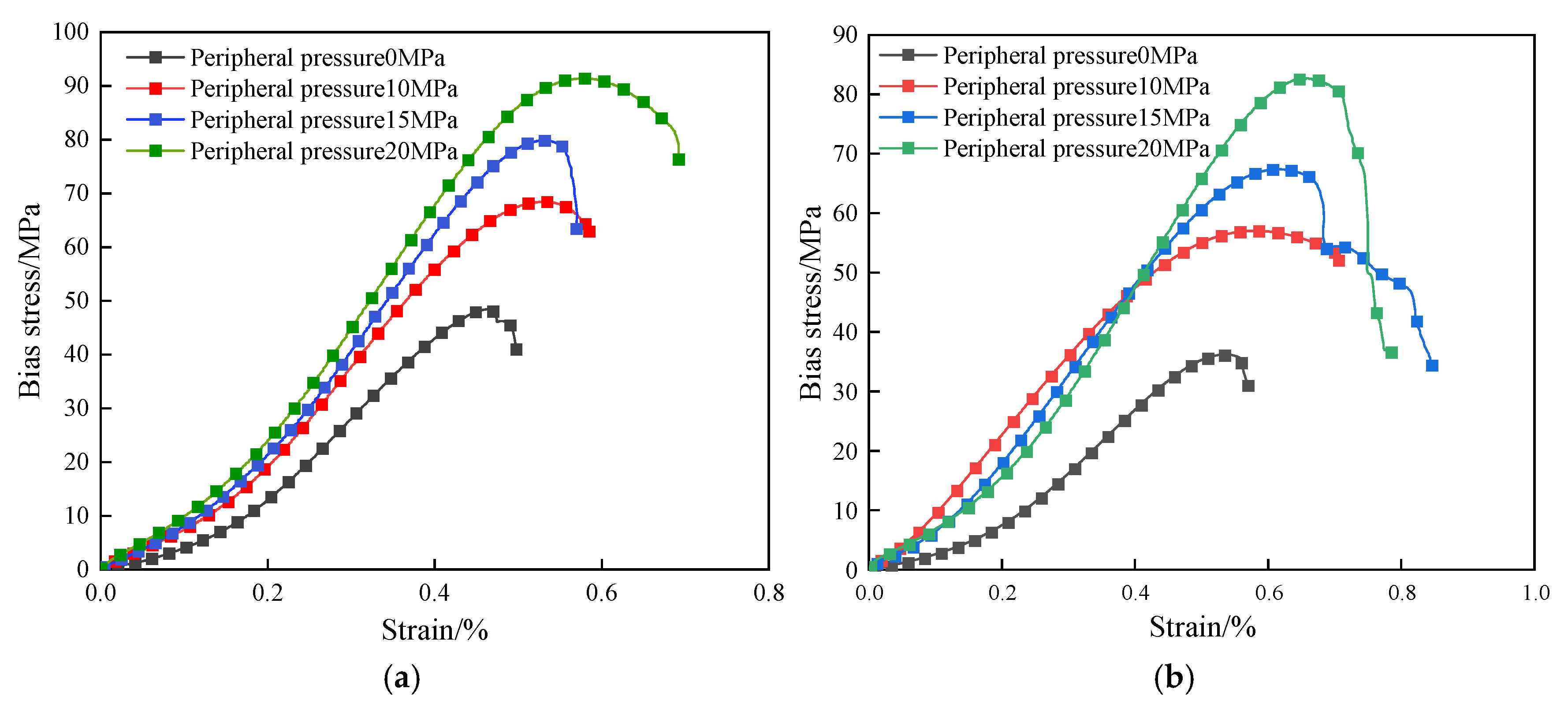
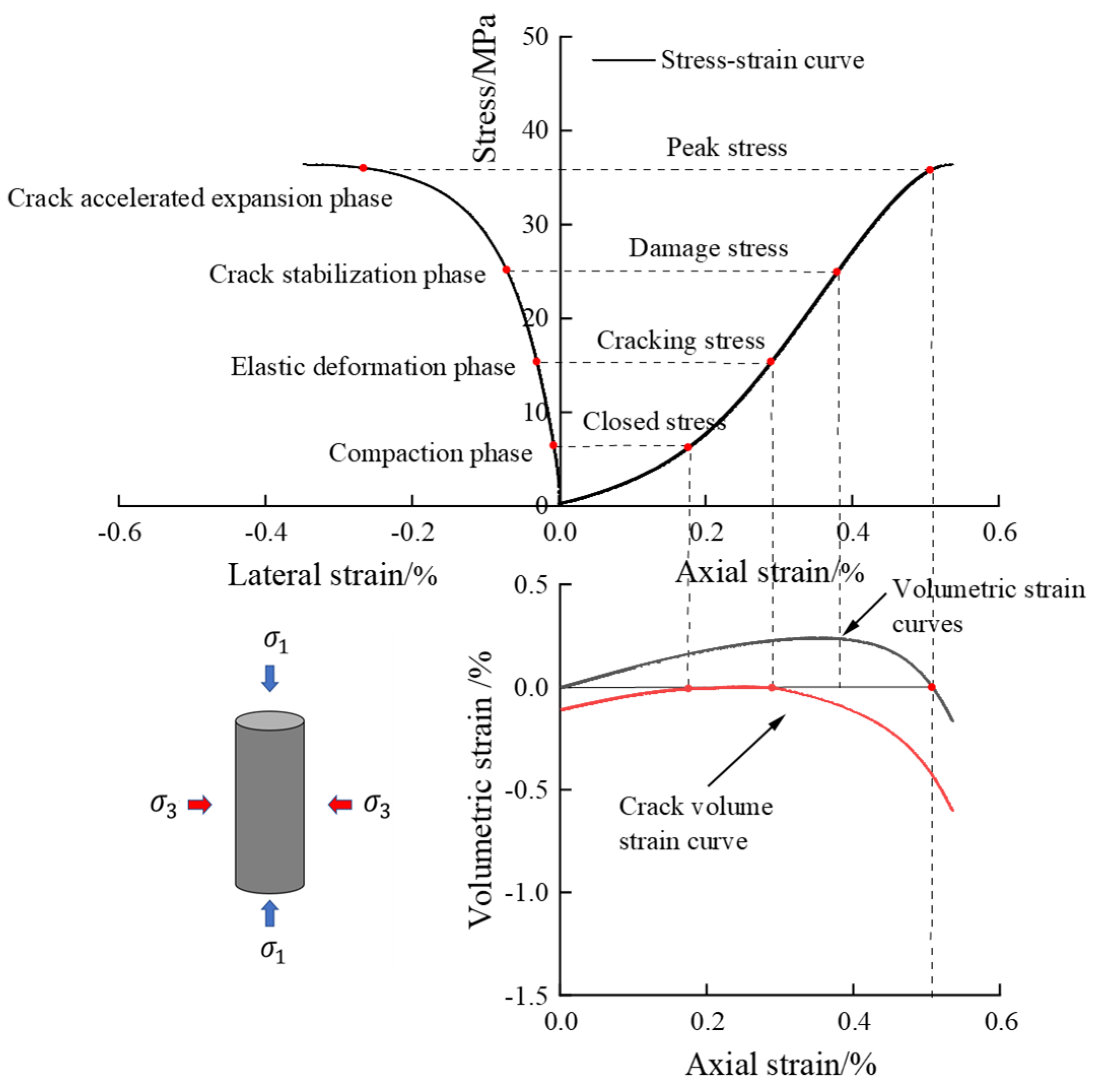
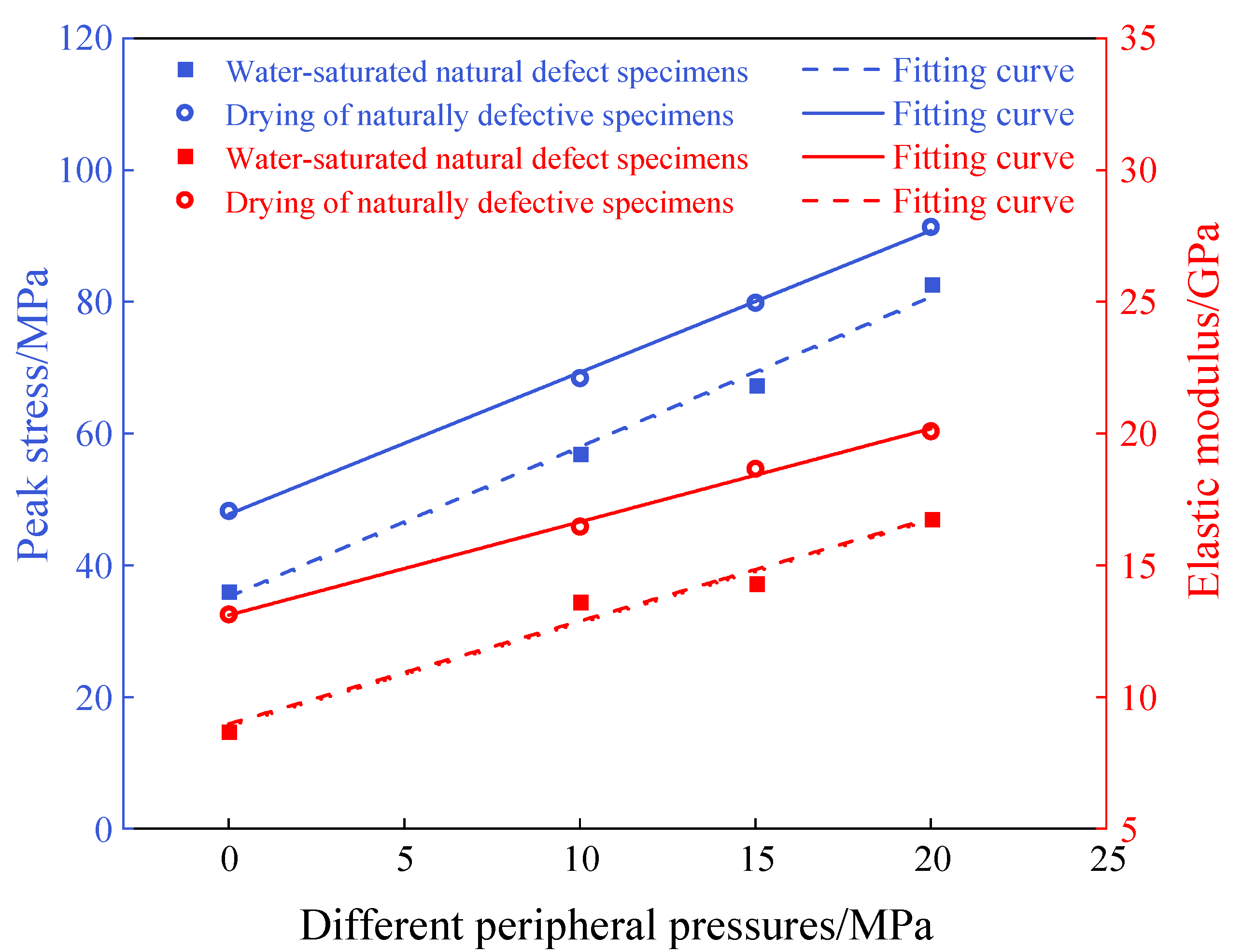
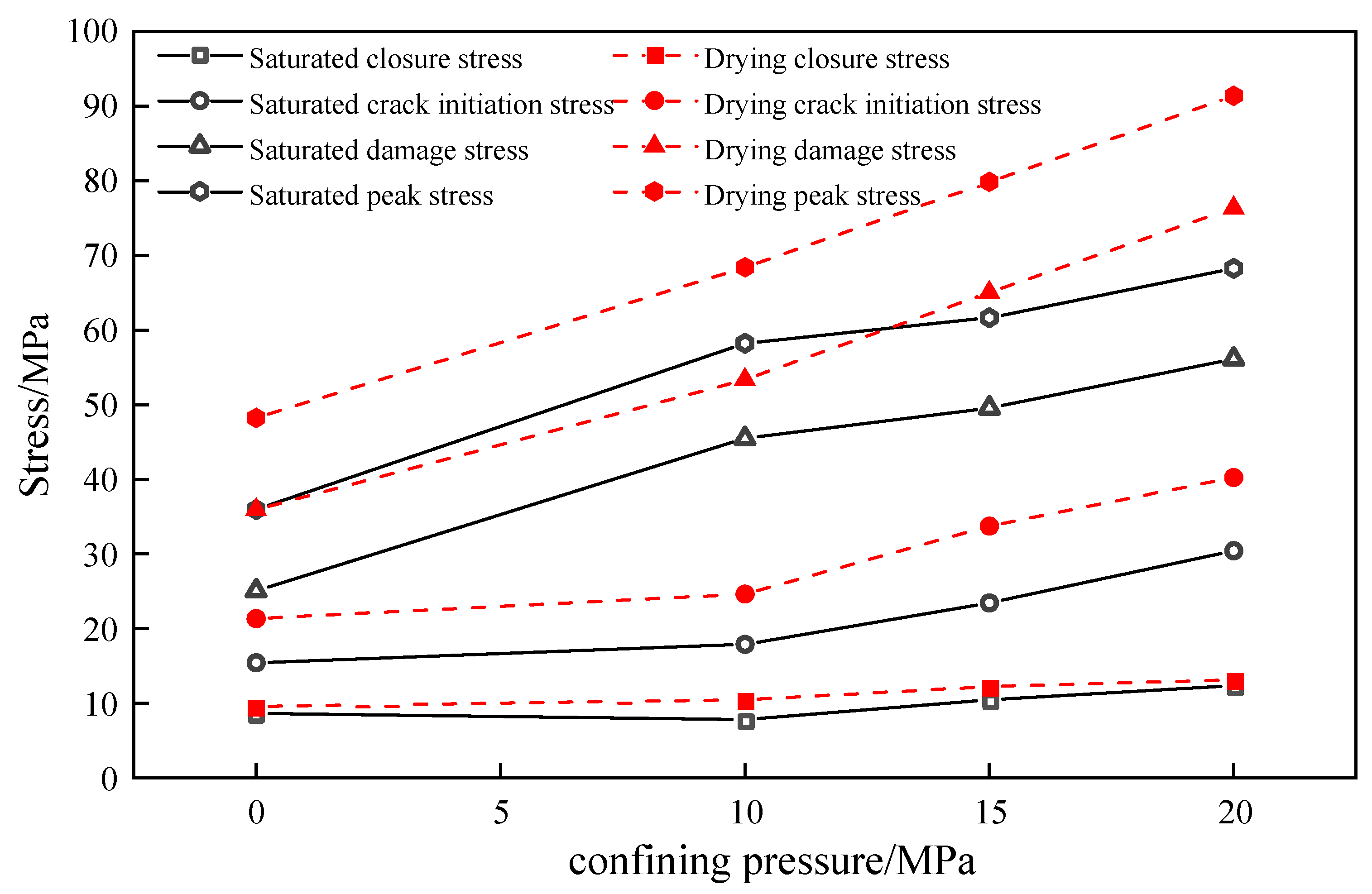
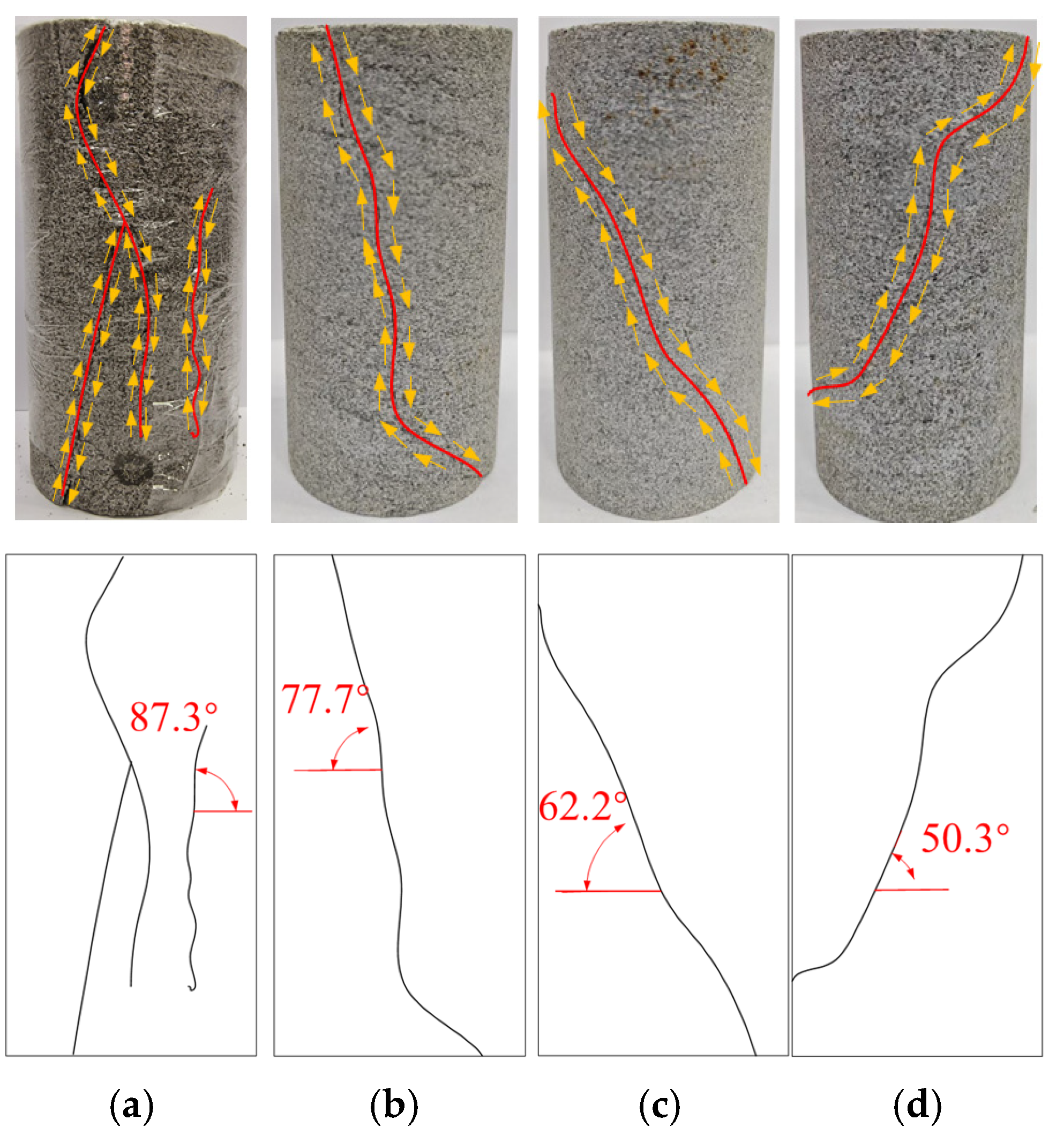
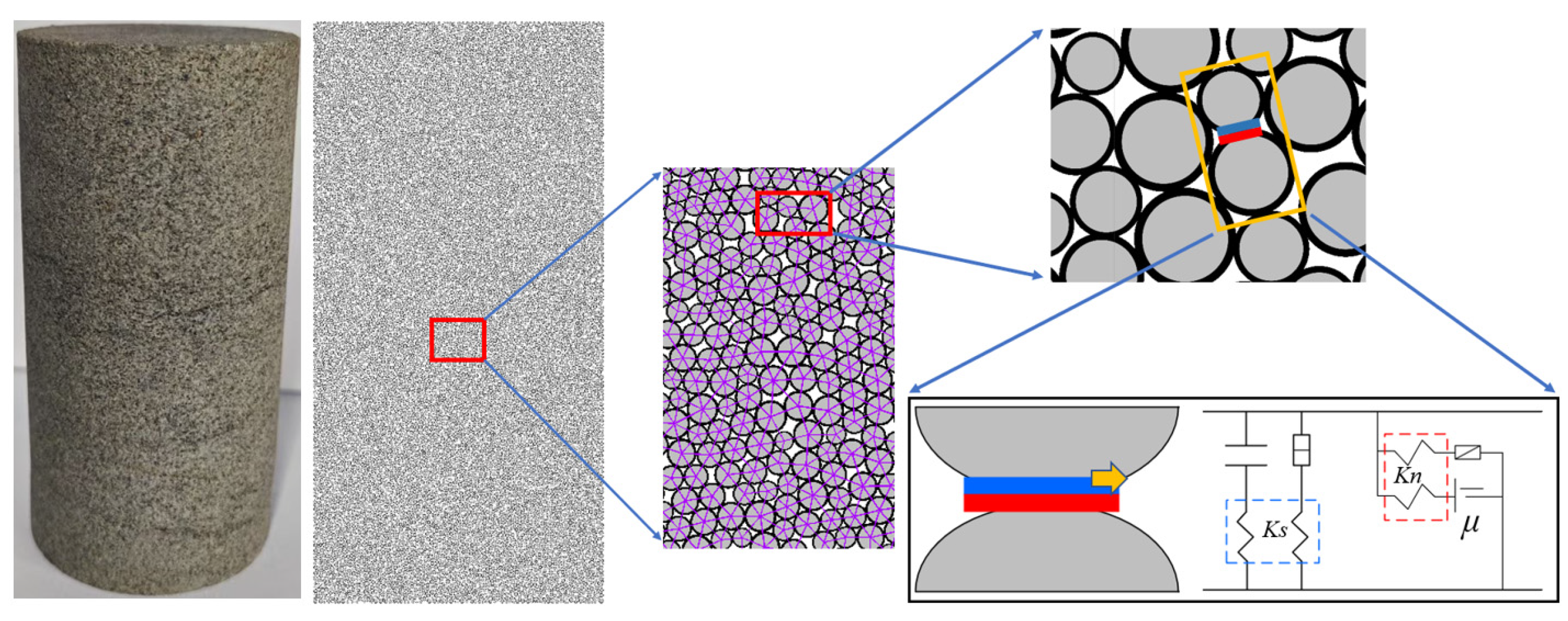
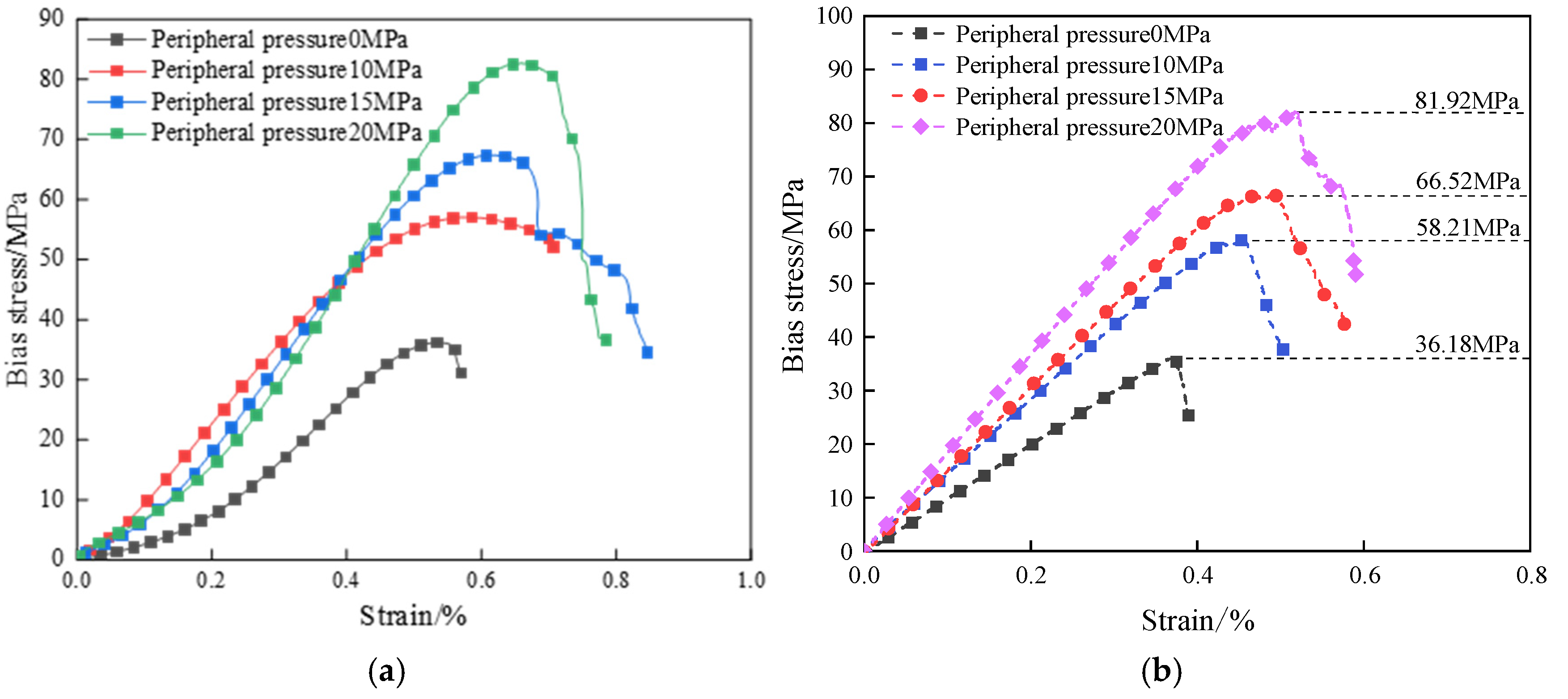

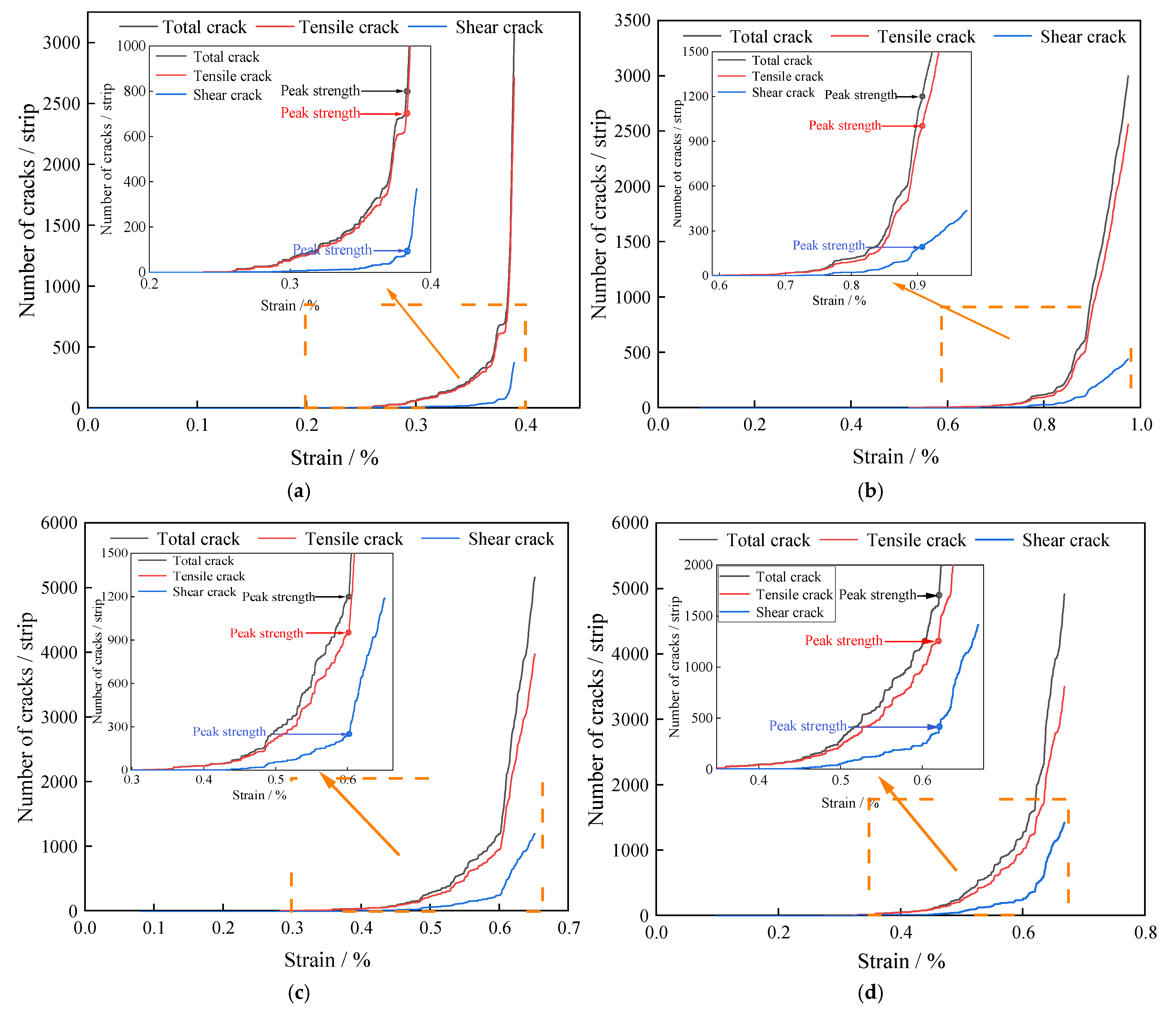
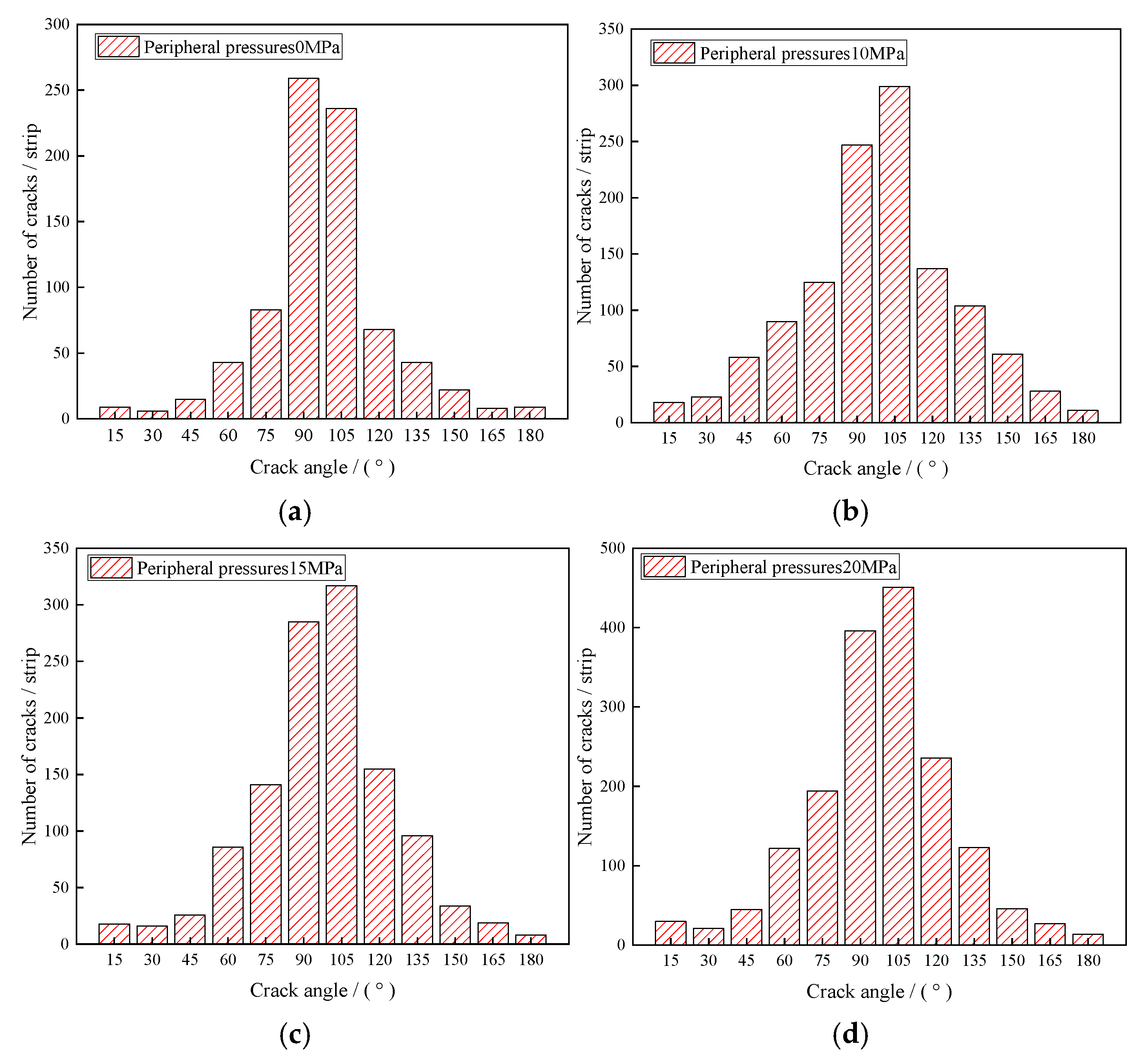
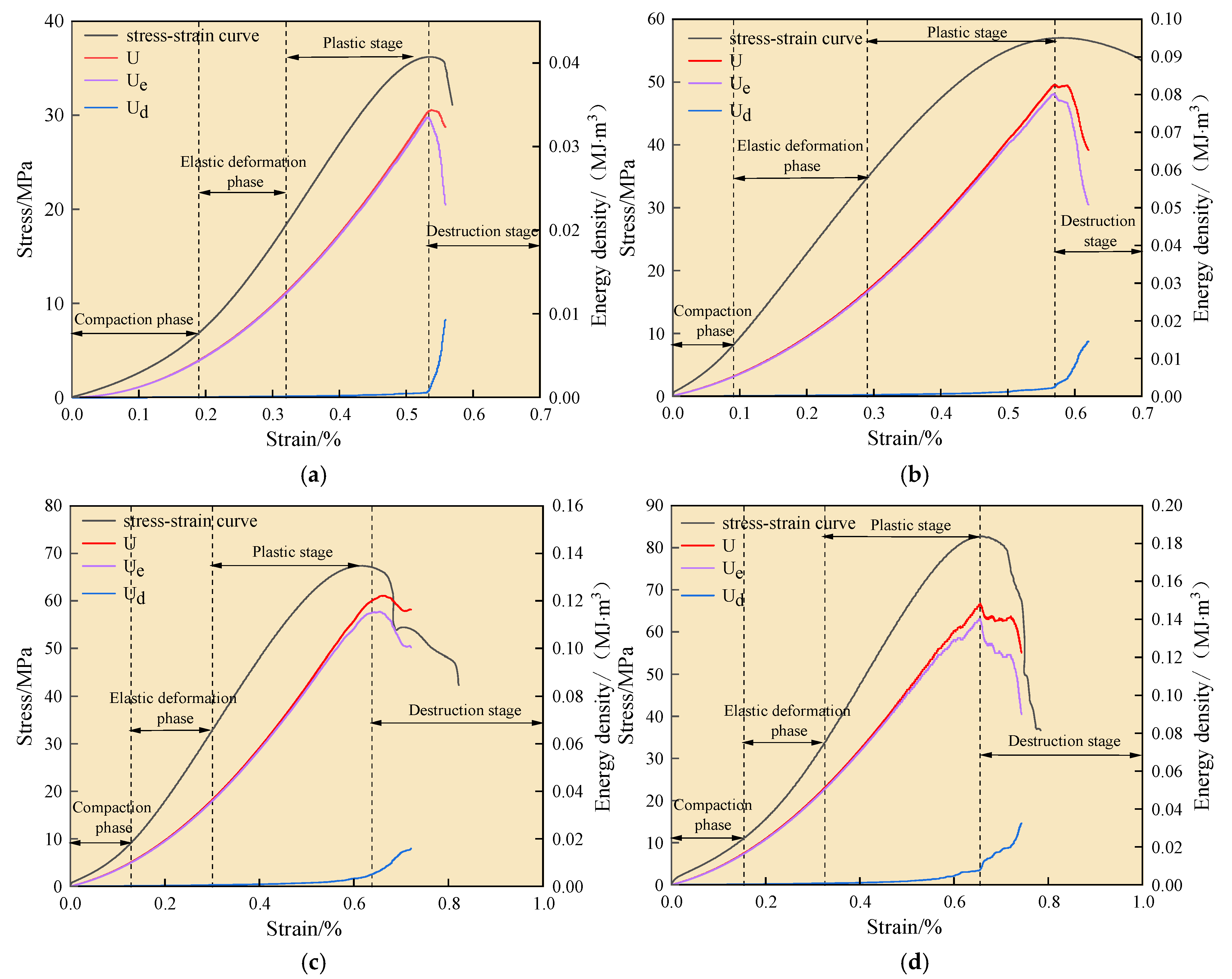
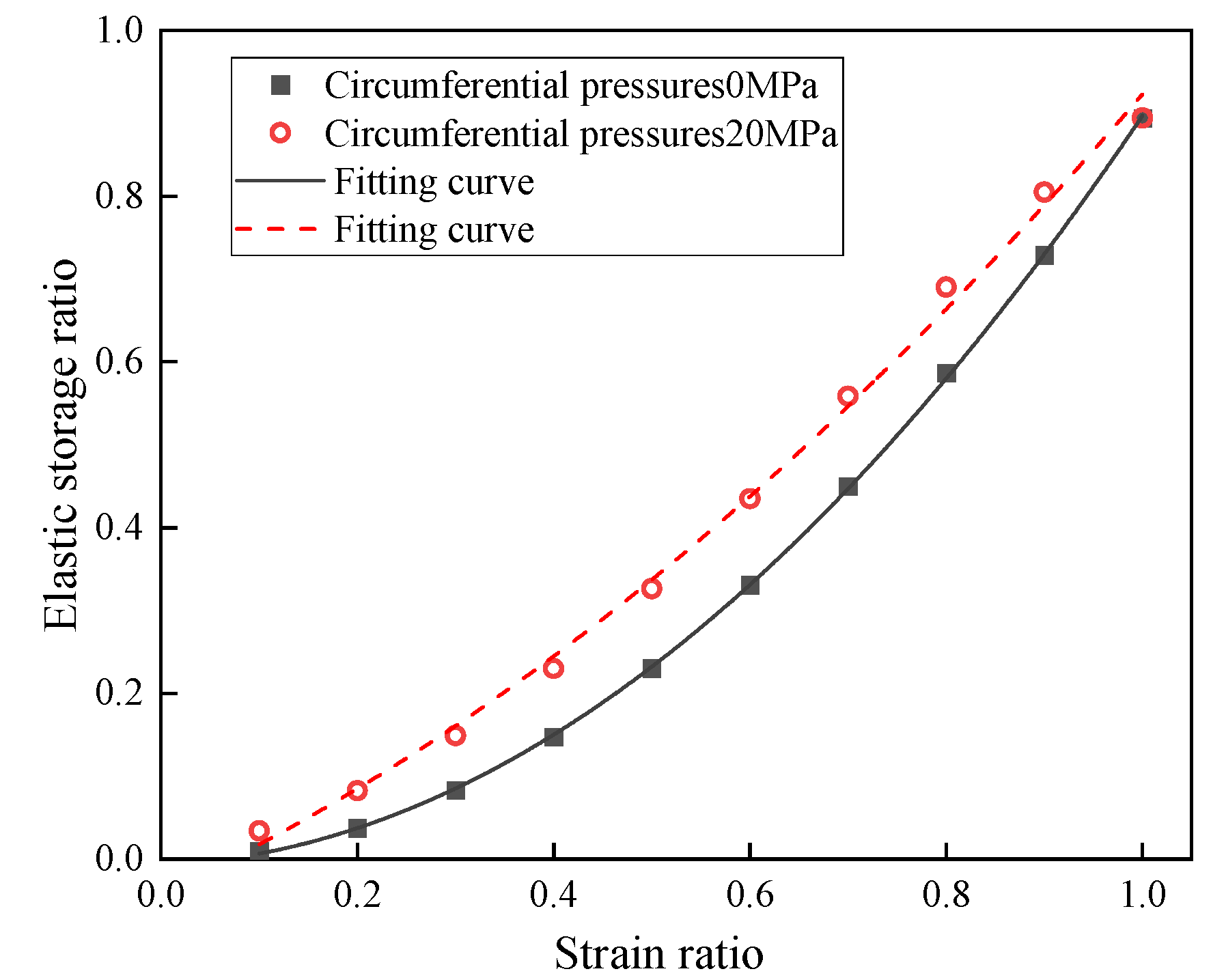
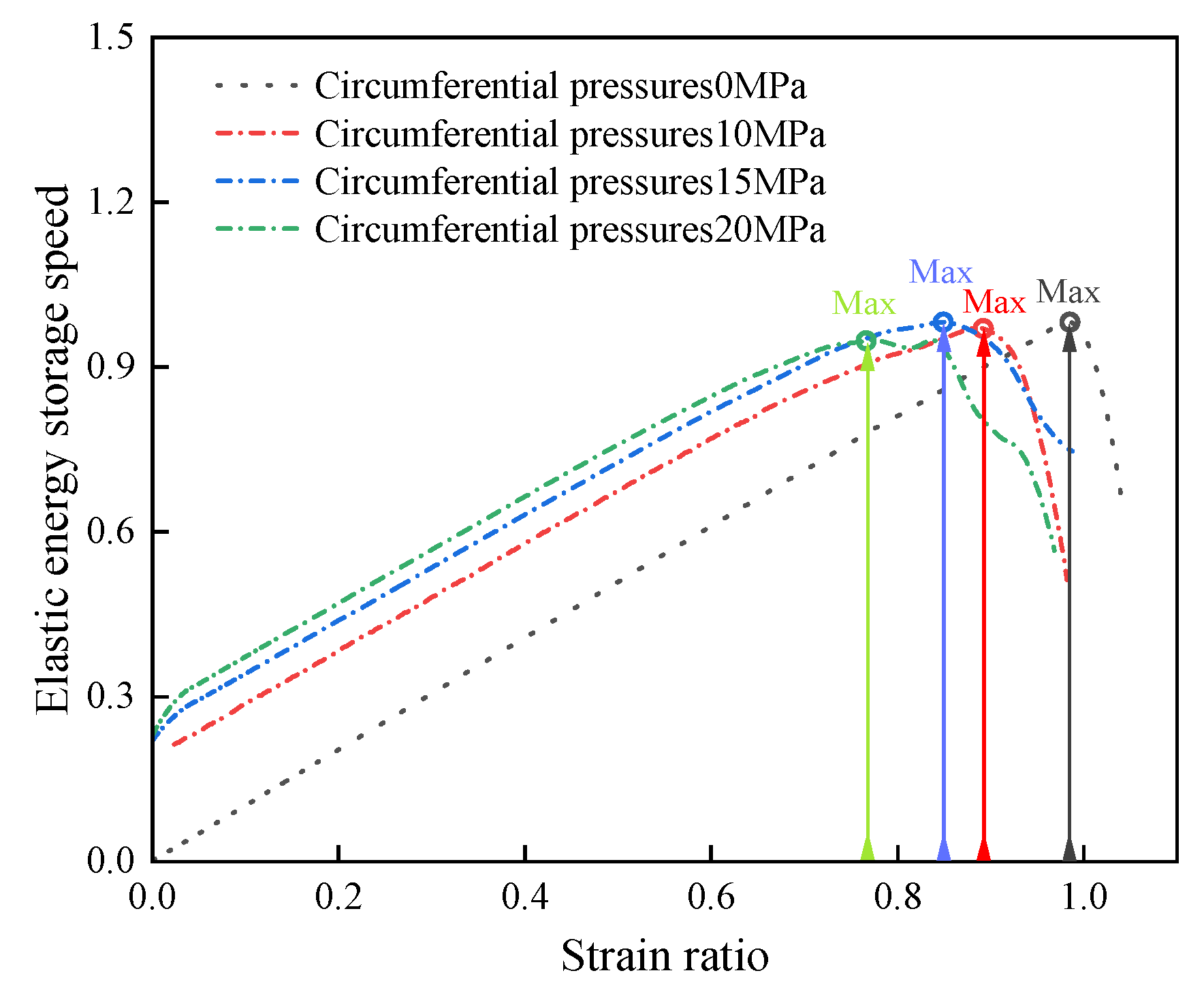
| Pressurization/MPa | Waterlogged State | Dry State | ||
|---|---|---|---|---|
| Test Number | Loading Rate MPa/s | Test Number | Loading Rate MPa/s | |
| 0 | BS-0 | 0.01 | GZ-0 | 0.01 |
| 10 | BS-10 | GZ-10 | ||
| 15 | BS-15 | GZ-15 | ||
| 20 | BS-20 | GZ-20 | ||
| Type | Rmin/mm | Rmax/Rmin/(mm) | Ec/GPa | μ | σc/MPa | c/MPa | Ø | ks/kn |
|---|---|---|---|---|---|---|---|---|
| water-saturated defective brittle material | 0.9 | 1.66 | 5.1 | 0.3 | 10.9 | 22.2 | 38 | 1.5 |
Disclaimer/Publisher’s Note: The statements, opinions and data contained in all publications are solely those of the individual author(s) and contributor(s) and not of MDPI and/or the editor(s). MDPI and/or the editor(s) disclaim responsibility for any injury to people or property resulting from any ideas, methods, instructions or products referred to in the content. |
© 2025 by the authors. Licensee MDPI, Basel, Switzerland. This article is an open access article distributed under the terms and conditions of the Creative Commons Attribution (CC BY) license (https://creativecommons.org/licenses/by/4.0/).
Share and Cite
Gao, Z.; Guo, S.; Yang, X.; Hu, S.; Huang, J.; Cheng, Y.; Yin, D.; Dou, J. Failure and Energy Evolution Characteristics of Saturated Natural Defective Material Under Different Confining Pressures. Materials 2025, 18, 2027. https://doi.org/10.3390/ma18092027
Gao Z, Guo S, Yang X, Hu S, Huang J, Cheng Y, Yin D, Dou J. Failure and Energy Evolution Characteristics of Saturated Natural Defective Material Under Different Confining Pressures. Materials. 2025; 18(9):2027. https://doi.org/10.3390/ma18092027
Chicago/Turabian StyleGao, Zhihao, Shihao Guo, Xiaoyong Yang, Shanchao Hu, Junhong Huang, Yafei Cheng, Dawang Yin, and Jinhao Dou. 2025. "Failure and Energy Evolution Characteristics of Saturated Natural Defective Material Under Different Confining Pressures" Materials 18, no. 9: 2027. https://doi.org/10.3390/ma18092027
APA StyleGao, Z., Guo, S., Yang, X., Hu, S., Huang, J., Cheng, Y., Yin, D., & Dou, J. (2025). Failure and Energy Evolution Characteristics of Saturated Natural Defective Material Under Different Confining Pressures. Materials, 18(9), 2027. https://doi.org/10.3390/ma18092027





